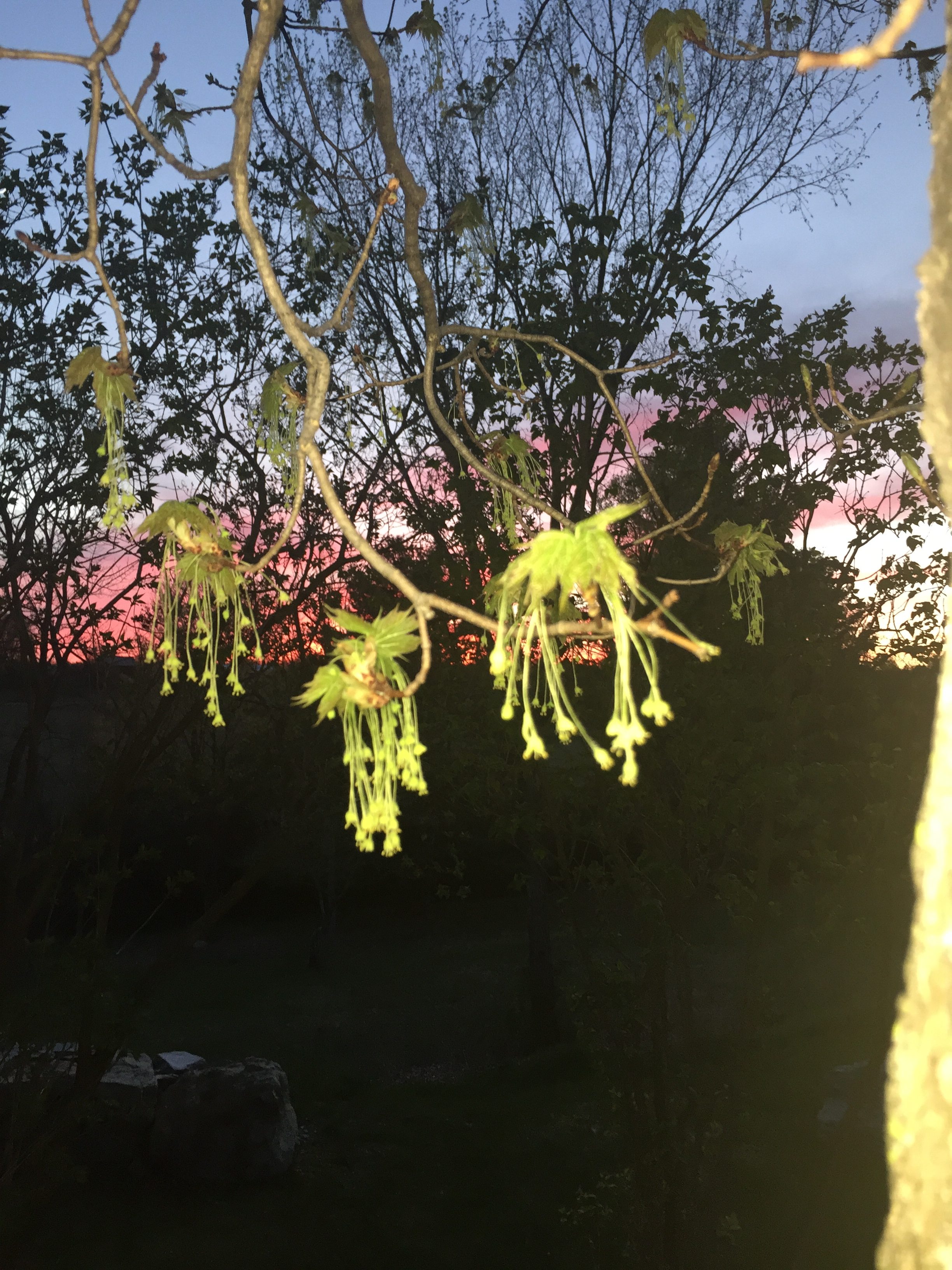The lead photo was taken yesterday (April 29) from our west yard in Middlebury, Vermont. The sunset is background for the new spring leaves and blossoms of a maple tree (that we planted 37 years ago). The image struck me as a metaphor for this point in the cycle of a school year.
Louise and I just returned from another wonderful day of reflection and projection with Barbie Perez and her fabulous faculty at La Scuola in Miami. The sun is setting on their most creative and productive school year, while new ideas for next year are blossoming. ’Tis a tremendously creative time.
Speaking of TIME, taking the time at this point in the year, typically all consumed with “wrapping up,” to pause and reflect is ALWAYS reaffirming and generative. Barbie is a wise leader, in that every year about this time, she sets aside a whole day to do just that.
During the morning of our day together, three teachers shared different but related projects that they had been guiding/following/developing throughout the year all based on the big question: What is migration?
One class discovered and researched sea turtles, another butterflies, and the third, birds…all in the neighborhood of the school. The webs of learning experiences were extensive and portrayed the students’ deep and lasting understanding of concepts, content and skills (both congnitive and 21st C, e.g., empathy, multiple perspectives, ecoliteracy)…each with an authentic contribution to the community of the school and to Miami: a book about sea turtles advocating for protection and beach cleanup (given to Turtle Hospital for their student tours), a book and a play about butterflies and butterfly/pollinator gardens, and a collection of instagram videos about indigenous birds and necessary habitats…all three featuring detailed observational drawings, painting, clay sculptures, and carefully edited writing.
At some time in the future, these publications will be available for you all to have, by request…stay tuned.
We reflected on each presentation following a protocol:
1. share what you notice and value about what you’ve heard
2. share what you wonder about, what questions do you have (and those were collected…not immediately answered by the presenter)
3. the presenter responds to questions and then
4. discussion evolves into everyone’s takeaways…in what ways will this effect/inform MY work. Everyone thinks together about possibilities, ideas, suggestions and implications for teaching and learning.
Following this protocol is frequently challenging, certainly for first timers, because we are so used to mixing up all three components into a mosh pit of superficial excitement, stepping on what each other is saying, and NOT REALLY LISTENING. This protocol encourages deep listening, and, therefore, deep thinking.
Here’s a sampling of notes I took in the “notice and value” parts of each:
Your writing assignments were so pertinent and provocative and meaningful to the students.Your learning adventures…I call them that because they were MORE than field trips…they were purposeful…part of their RESEARCH.Your research involved REAL issues…the injury of sea turtles…pollination.Loved the idea of the students telling a story about their traumatic experience and recovery.The students have become environmental stewards.Your reflections in your “Daily” [a daily newsletter blog post] was inspirational to follow.Your passion for the subject was obviously contagious and fully transferred to the students.They overcame all “fears of the outdoors”…like it or not, they’re bug lovers forever.Their retention of facts was remarkable…and, I’m sure, stemmed from their genuine interest and passion for the research.You let them wonder, and you valued their theories…so they felt free to share their thinking and to think critically together.You collaborated with other teachers, from other classes and other disciplines, especially the atelierista…so the resulting work is much richer and more beautiful.The students obviously worked hard, many drafts, and took great pride in their work.You pulled off an amazing “aikido” move…instead of resisting the ubiquitous presence of student phones, you captured their interest and energy using instagram and video.
In the wondering and projection discussions several teachers quoted the children:
You know, we are teaching each other. We are teaching you about turtles…and you are teaching us about art materials.The turtles are looking to find their friends again.When I showed the one year old the caterpillar, he said “butterfly.” He taught ME something. The babies have become friends.We discovered things together.If we plant these gardens [for pollinators] we can help the world.
It’s probably easy to imagine from tone and content of these reflections, that the energy that flowed into the afternoon for the “projection into 2017-2018” planning was considerable, positive, inventive, all building on the past experiences.
La Scuola is moving to a new-to-them campus, renovating an older school on an Episcopal church site at 7412 Sunset Drive. Every window looks out on three acres of green. They move in June 1st. It’s all beyond exciting, because this little engine that could has finally found the ideal home. Not surprisingly, the questions the faculty resolved to follow were:
Who else lives here? How are they connected to us…and we to them? How can we conserve this place and make it better?
Welcome HOME La Scuola. May your sense of place become ever more profound.
To me, you are like these renegade daffodils in our orchard...blossoming in a new field of green.



















